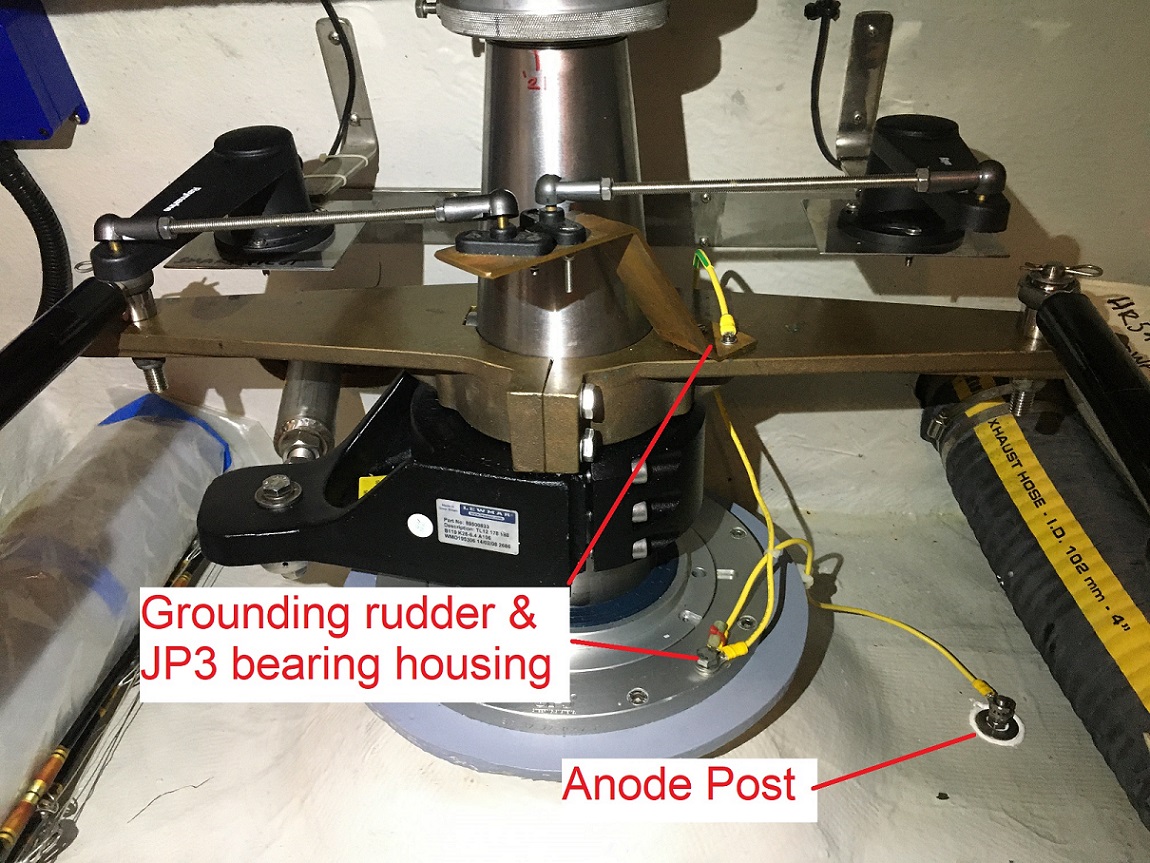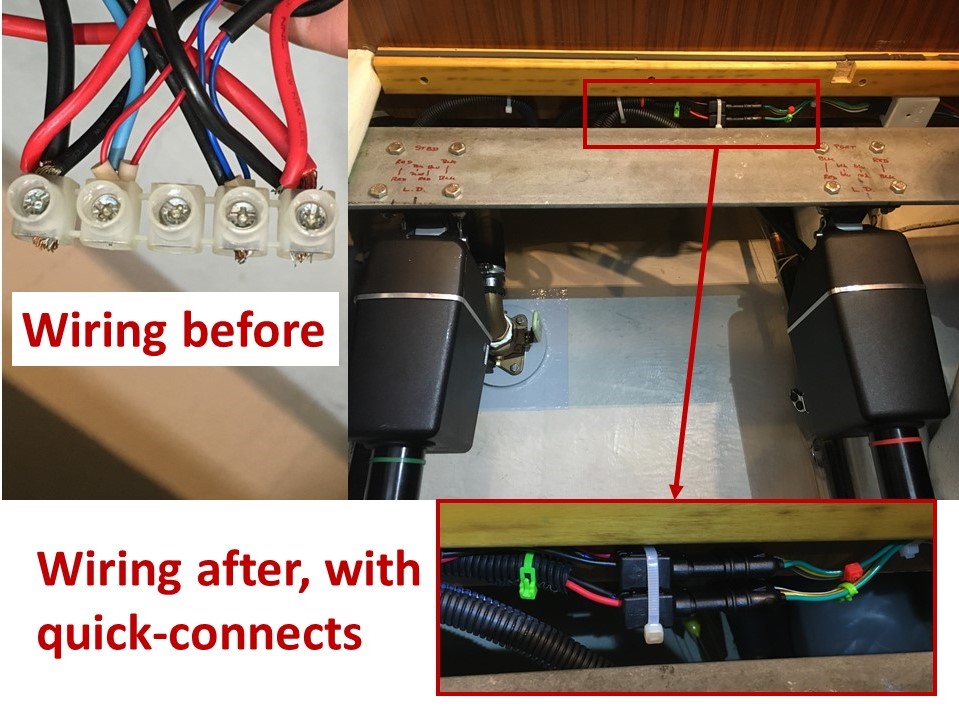Tuesday 2-Nov, re-launch 2021, HHN day 34: Rain, rain go away, come back another day. Please. Installed rudder anode. Added electrical quick-connects to the linear drives. Cinema in the evening.
It was not supposed to rain until midday, and I had planned to spend the morning polishing the hull. But the rain already started by 8am. I think there is a conspiracy against the hull being polished this week!
It rained on and off all day. And it’s cold! 10 degC maximum today. Hard to believe we were complaining about the heat just 2 weeks ago. But inside the boat, with the heating on, it’s really toasty! It will be indoor jobs only today. With the forecast, I have planned on getting under the aft berth to do 2 jobs there. Firstly, to add a protective anode to the rudder system, and secondly to add quick connects to the autohelm linear drives.
When I dropped the rudder to replace the seals in the JP3 rudder bearing, I found pretty severe galvanic corrosion to the aluminum bearing housing. There was also evidence of galvanic action on the rudder stock too, right where it enters the fiber-glass of the rudder. Over the years we have also noted the small anode on the tip of the Gori propeller gets eaten very quickly. Conclusion: given we are mostly at anchor (not near a dock/marina) we suspect there is micro current running between the rudder assembly and the propeller.
We know the propeller is connected to the negative side of the boat’s DC circuit. And we hope that the rudder is completely isolated. I check this (out the water) and find this is in fact the case. Until that is, the autohelm linear drives are attached, then the rudder is also connected to the negative side. But the bearing housing, where most of the corrosion was found, is still isolated.
Anyway, to kill all future galvanic action I have decided to take drastic action! Today I install a small anode through the hull (..yes, another hole in the hull!!) adjacent to the rudder. I then connect this to both the bearing housing and the rudder. Now that both are connected together and have a protective anode, I should have thwarted the corrosion mechanism. It will be interesting to see how quickly this new anode erodes. And the Gori anode too. But for now, I consider this “job done”.
And now to the autohelm wiring. On Cloudy Bay, we have 2 completely separate autohelm systems with a change-over switch between them. With just 2 of us sailing Cloudy Bay, we need to ensure we are covered for any autohelm failure. But both systems use the same twin linear drives to physically turn the rudder. With twin linears we already have a form of redundancy, because one linear drive can in theory coupe alone. Though I’m not convinced. But I have 2 (yes 2!) spare linear drives. But if I need to swap them out whilst at sea, it will take me some time (while Oana hand steers) because of the archaic way they are wired in.
Hence today I install electrical quick-connects, purchased from Amazon. Being designed for vehicle trailer lighting, they are rugged construction plugs and sockets, so should be up to the job. 2 hours of wire cutting, crimping, and ty-wrapping, and the new connectors are neatly in place. Now for the test. We switch on the autohelm and Oana presses the “+10 deg” button while I observe that each linear drive is working in the correct direction. Brilliant, it seems to work well. Now this is an upgrade I’ve been wanting to do for quite a while. Fingers crossed it lasts the test of time OK.
After tidying up and reinstating the aft berth, it’s time for our outing this evening. We are off to the cinema, again! This time to watch “Dune”. We are not normally into sci-fi films but this one has good ratings. It took a bit of getting into the plot, but by the end we were really enjoying it. Set in year 10,219 was almost as believable as last week’s James Bond movie!
On the drive back to the boat, it’s pretty cold outside now. 42degF (6 degC?). Plus, there is quite a thick mist on the road and we are a bit wary of animals. There are so many animals in the forests around here, particularly deer. We often see them running across the road in front of us. But thankfully we get back without issues. Now, I ask this: why don’t cars have radar, I wonder? I mean, in fog on the boat, we put the radar on to help us spot deer! You may laugh, but the 2nd time we entered Herrington marina, a deer did actually swim across our bow!
Anyway, it was nice to have an evening off and even nicer to climb back into the cozy boat with the heating on, and we are very quickly snug under our thick duvet. Maybe we will dream of the new quick connect fittings or new rudder anode, which now lie hidden just inches below us as we go to sleep. Zzzzzz



4 comments
Good idea to install that rudder anode. Your description of the stray current and corrosion reminded me of Sailing Hilma. Their rudder stock actually snapped off in the middle of the Pacific Ocean. They later discovered a loose wire which turned their SS rudder shaft into a dissolving anode. It’s all on YouTube.
Andrew … yes thats exactly what I want to avoid! On the other had, it will take alot of Galvanic action to destroy the 120mm diameter solid Stainless rudder stock that CB has. Its a monster.
Hello Glen
Have you used a reference electrode and multimeter to control the anodes. Just ordered the Silvion kit that seems to be also used in …offshore oil rigs. Looking for some real world experience on this topic of galvanic protection.
Yes, I must look into this …. and try out those measurements. Maybe, by the time we get back to USA in May’22 you will have tried it and can explain to me.
Comments are closed.